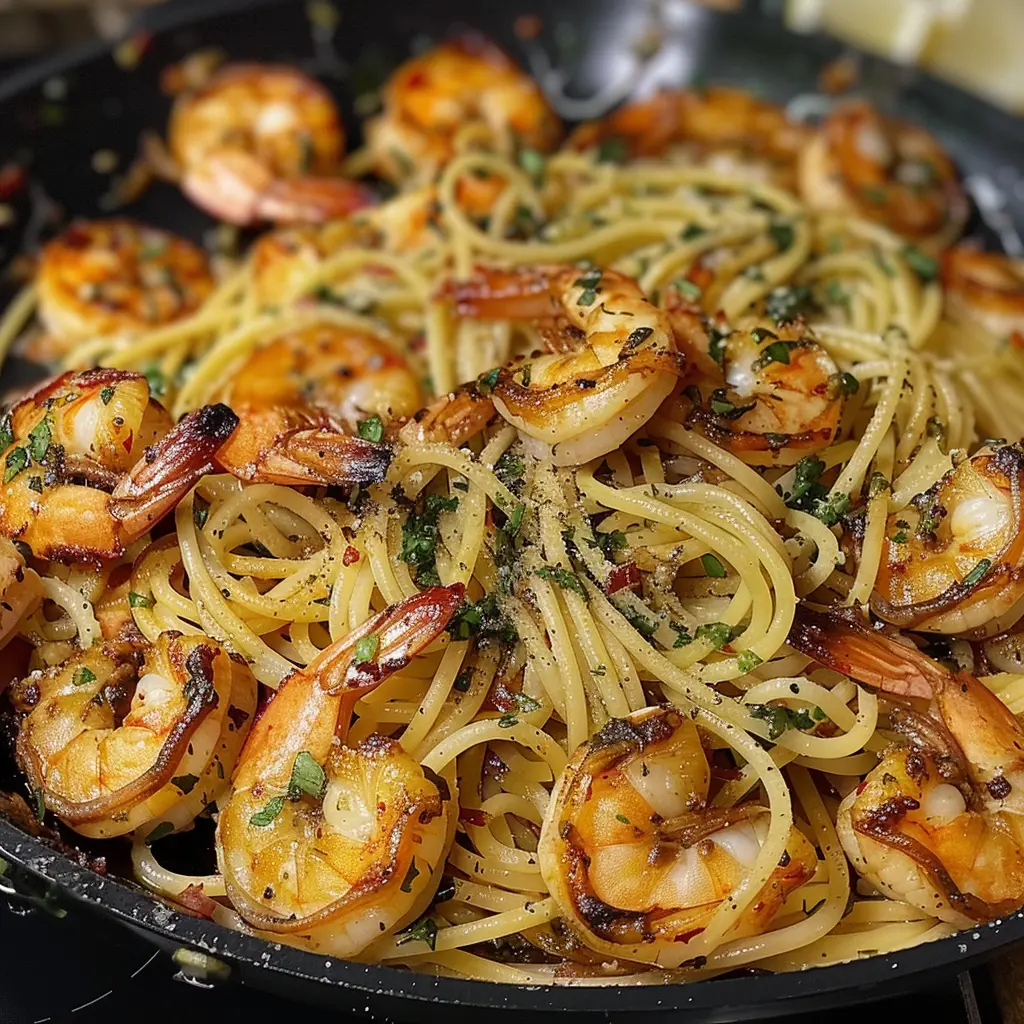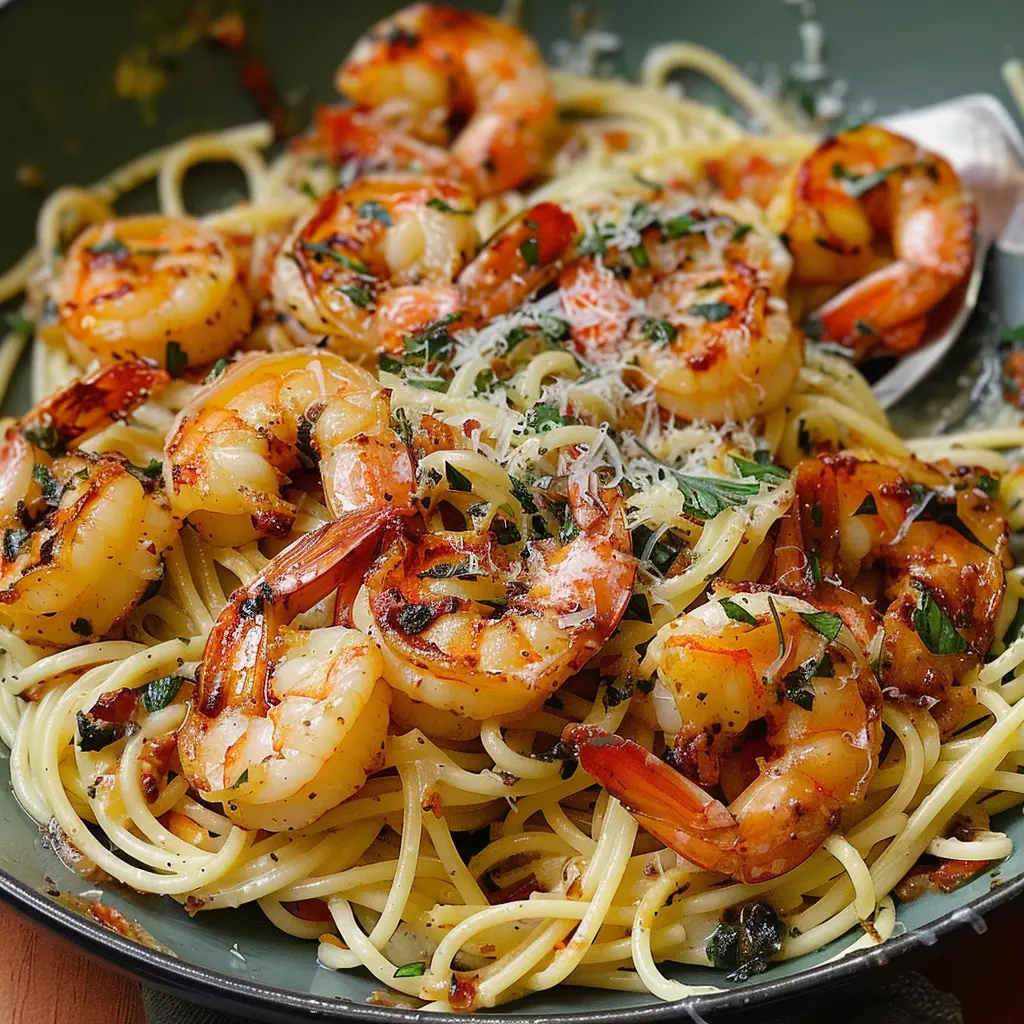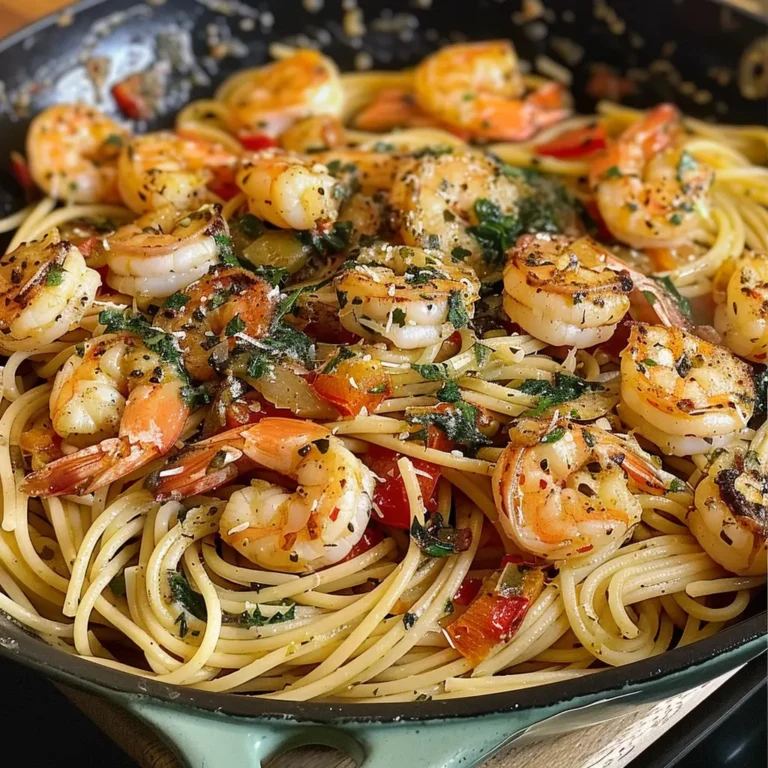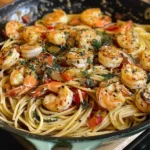Garlic Shrimp Pasta is a simple yet flavorful dish that’s perfect for both a quick weeknight dinner and a special occasion meal. Its popularity stems from its ease of preparation, taking only 20 minutes to cook, while delivering a restaurant-quality flavor. The combination of shrimp and pasta creates a versatile canvas for countless variations, making it suitable for any palate. Shrimp is a protein that’s tender yet hearty, while pasta provides a comforting and filling base. This dish also welcomes a variety of seasonings and sauces, ensuring that each serving is unique and delicious.
Ingredients Overview
Here’s a breakdown of the key ingredients you’ll need to make a delectable Garlic Shrimp Pasta:
- Shrimp: When choosing shrimp, opt for fresh or frozen varieties with a firm texture and a slightly salty smell. Fresh shrimp should have a translucent sheen. Avoid those that appear slimy or have a strong fishy odor./
- Garlic: Garlic is the soul of this dish, adding depth and an aromatic punch. For the best results, use fresh garlic cloves, finely minced, rather than pre-chopped or powdered versions, as these may lack in flavor.
- Pasta: The best types of pasta to pair with shrimp are linguine, spaghetti, or fettuccine. These long strands cling to the sauce and create a well-balanced bite with the shrimp.
- Butter, Parmesan, and Olive Oil: These ingredients act as flavor enhancers, creating a rich and creamy base for the shrimp and pasta. Butter adds a smooth texture, while Parmesan cheese provides a salty, nutty finish. Olive oil helps coat the pasta and shrimp, infusing the dish with a hint of Mediterranean flavor.
- Optional Ingredients: For added zest, consider adding lemon juice, chili flakes, or a splash of white wine. These elevate the flavors and bring a fresh brightness to the dish.
By using these fresh ingredients, you can create a flavorful and easy-to-make dish that will impress at any dinner table.

Step-by-Step Cooking Instructions for Garlic Shrimp Pasta
Garlic Shrimp Pasta is a delicious and quick dish that comes together in just a few easy steps. Below is a detailed, step-by-step guide to help you create this mouthwatering meal.
Step 1: Preparing the Shrimp
Before cooking, it’s crucial to properly peel and devein the shrimp. Follow these tips to make sure your shrimp are clean and ready for cooking:
- Peeling the Shrimp: Start by gently pulling off the head (if not already removed). Next, peel away the shell from the body, starting at the legs. For some recipes, leaving the tail on adds visual appeal, but it’s optional.
- Deveining the Shrimp: To devein the shrimp, make a shallow cut along the back with a small knife. Remove the dark vein (which is the shrimp’s digestive tract) using the knife or your fingers. Rinse the shrimp under cold water to ensure they’re fully clean. Learn more about preparing shrimp here.
Step 2: Cooking the Pasta
Cooking the pasta perfectly is key to balancing the flavors and texture of this dish. Follow these best practices:
- Boiling Water: Fill a large pot with water, add a generous amount of salt (it should taste like the sea), and bring it to a boil. Salt is essential for flavoring the pasta.
- Choosing the Right Pasta: Opt for linguine, fettuccine, or spaghetti, as these long pasta shapes work well with the sauce and shrimp.
- Cooking Time: Cook the pasta until it’s al dente—firm but not mushy. This usually takes about 7–9 minutes, depending on the pasta type. Be sure to reserve a cup of pasta water before draining, as it can be used later to thicken the sauce.
Here’s a guide to cooking perfect pasta.
Step 3: Making the Garlic Butter Sauce
The sauce is where the flavors come together. Here’s how to make a rich, flavorful garlic butter sauce:
- Heating the Pan: In a large skillet, heat 2 tablespoons of olive oil over medium heat.
- Cooking the Garlic: Add 5–6 minced garlic cloves to the pan. Sauté the garlic for about 30 seconds to 1 minute, until fragrant but not browned (burnt garlic will ruin the flavor).
- Adding Butter: Stir in 4 tablespoons of unsalted butter and let it melt, creating a creamy base for the shrimp. If you’re feeling adventurous, add a splash of white wine for an extra layer of flavor.
Step 4: Combining Shrimp, Sauce, and Pasta
Now it’s time to bring everything together without overcooking the shrimp or pasta:
- Cooking the Shrimp: Add the prepared shrimp to the garlic butter sauce in a single layer. Cook for 2–3 minutes on each side, until they turn pink and opaque. Be careful not to overcook them, as shrimp become rubbery if left on the heat too long.
- Mixing the Pasta: Once the shrimp is cooked, reduce the heat to low and add the cooked pasta to the skillet. Toss everything together, ensuring the pasta is fully coated in the garlic butter sauce. If the sauce is too thick, gradually add the reserved pasta water to reach the desired consistency.
- Final Touches: Sprinkle grated Parmesan cheese over the dish and toss to combine. If desired, add chili flakes and a squeeze of lemon juice for a spicy, zesty finish.
With these steps, you’ll have a restaurant-quality Garlic Shrimp Pasta ready in no time. Enjoy!
Different Variations of Garlic Shrimp Pasta
Garlic Shrimp Pasta is a versatile dish that can easily be adapted to suit your taste. Here are some popular variations that can elevate the flavor profile:
1. Creamy Garlic Shrimp Pasta
For a richer, creamier version, add heavy cream to the sauce. After sautéing the garlic, stir in ½ cup of heavy cream and let it simmer for a few minutes before adding the shrimp. This creates a luxurious, velvety texture that pairs beautifully with the shrimp and pasta.
Learn more about adding cream to pasta here.
2. Lemon Garlic Shrimp Pasta
If you prefer a bright, tangy flavor, adding lemon juice is the way to go. After cooking the shrimp, squeeze the juice of one fresh lemon over the pasta and toss. The acidity cuts through the richness of the butter, creating a perfectly balanced dish.
3. Spicy Garlic Shrimp Pasta
For those who enjoy a kick of heat, incorporate chili flakes or freshly chopped chilies into the sauce. Add 1 teaspoon of chili flakes or 1 diced red chili when sautéing the garlic. This adds a spicy element that complements the shrimp’s sweetness.
4. Healthy Garlic Shrimp Pasta
If you’re looking for a healthier option, reduce the amount of butter and opt for olive oil instead. Pair this with whole-wheat pasta to increase fiber content. You can also toss in some sautéed spinach or cherry tomatoes for added nutrients and color.
Serving Suggestions
To complete your Garlic Shrimp Pasta meal, consider pairing it with the following:
- Salads: A light green salad with a lemon vinaigrette is a refreshing contrast to the richness of the pasta.
- Garlic Bread: Serve with crusty garlic bread for a satisfying crunch and to mop up any extra sauce.
- Wine: A glass of white wine like Sauvignon Blanc or Pinot Grigio pairs perfectly with the shrimp and garlic flavors.
For presentation, garnish the dish with fresh parsley and lemon wedges. Serve in shallow bowls to keep the pasta warm and showcase the shrimp on top for a visually appealing meal.

Additional Tips for Perfect Garlic Shrimp Pasta
To make your Garlic Shrimp Pasta truly shine, follow these expert tips:
1. Avoiding Overcooking Shrimp
One of the most common mistakes when cooking shrimp is overcooking. Shrimp cook very quickly—typically in 2 to 3 minutes per side. Once they turn pink and opaque, immediately remove them from the heat. Overcooked shrimp become rubbery, losing their tenderness and juiciness. To ensure they’re cooked perfectly, cook them in a single layer and flip when the color changes.
2. Adjusting Garlic Intensity
Garlic is the star of this dish, but its intensity can be adjusted to suit your preference. For a milder flavor, use 2–3 cloves of garlic and cook it briefly (about 30 seconds) to soften the sharpness. If you love garlic and want a more pungent taste, use 5–6 cloves and sauté them until golden brown. Learn more about how to cook garlic properly.
3. Balancing Flavors (Fat, Acidity, and Spice)
To achieve a well-balanced dish, it’s essential to balance the richness of butter and olive oil with acidity and spice:
- Fat: Butter and olive oil create a rich, smooth base. If the dish feels too heavy, cut back slightly on butter or replace part of it with olive oil for a lighter feel.
- Acidity: Lemon juice or a splash of white wine brightens the dish, cutting through the richness. Add these ingredients towards the end to maintain freshness.
- Spice: Add chili flakes or a dash of hot sauce for a spicy kick. Adjust the amount based on your heat tolerance.
With these tips, your Garlic Shrimp Pasta will have a perfect balance of flavors, ensuring a delicious and satisfying meal.
Frequently Asked Questions
Can I use frozen shrimp instead of fresh?
Yes, frozen shrimp works just as well as fresh shrimp in this recipe, and it’s often more convenient. To thaw frozen shrimp properly, place them in a colander under cold running water for 5–10 minutes, moving them around to ensure even thawing. Once thawed, pat them dry with a paper towel to remove excess moisture. Avoid thawing shrimp at room temperature or in warm water, as this can affect their texture. Learn more about thawing shrimp here.
What pasta works best with this dish?
The best pasta to pair with Garlic Shrimp Pasta includes linguine and spaghetti, as their long, thin strands cling to the sauce, providing a good balance with the shrimp. Fettuccine is another great option, offering a slightly wider pasta that adds a bit more bite to the dish. For a lighter option, you can use angel hair pasta, though it cooks faster, so be mindful of the time.
Can I make this dish ahead of time?
Yes, you can make Garlic Shrimp Pasta ahead of time, but to maintain quality, store the shrimp and pasta separately. Reheat the shrimp gently in a skillet over medium-low heat with a splash of olive oil or butter to prevent overcooking. Reheat the pasta by adding it to the sauce with a bit of reserved pasta water or broth to loosen it up. Avoid using a microwave, as this can cause the shrimp to become rubbery.
Is this recipe gluten-free?
This recipe can easily be made gluten-free by using gluten-free pasta. Opt for rice-based, corn-based, or chickpea-based pastas that closely resemble traditional pasta in texture and flavor. Additionally, ensure that the Parmesan cheese and any other packaged ingredients you use are gluten-free, as some may contain additives.
Common Mistakes to Avoid
1. Overcooking the Shrimp
Shrimp cook quickly, usually in 2–3 minutes per side. Overcooking them results in a tough, rubbery texture. Cook just until they turn pink and opaque, then remove from heat immediately.
2. Burning the Garlic
Garlic burns fast, which can make the dish bitter. Sauté it for 30 seconds to 1 minute, just until it’s fragrant and lightly golden, but not brown.
3. Using Too Much Pasta or Sauce Imbalance
Using too much pasta can dilute the sauce’s flavor. Stick to recommended amounts to ensure a well-balanced dish, where the pasta is properly coated but not swimming in sauce. Add reserved pasta water to adjust the consistency if needed.
Health Considerations and Nutritional Information
Garlic Shrimp Pasta is rich and flavorful, but there are ways to make it healthier:
- Caloric Breakdown: A typical serving contains around 500–600 calories, depending on the amount of butter and cheese used.
- Lower-Calorie Alternatives: Reduce calories by using less butter or substituting it with olive oil. For a lighter version, skip the cream and opt for low-fat alternatives like Greek yogurt or light cream.
- Nutritional Benefits of Shrimp: Shrimp are a lean source of protein and low in calories. They’re also rich in omega-3 fatty acids and vitamins D and B12, making this dish not only delicious but nutritious as well.
Conclusion
Garlic Shrimp Pasta is a quick, delicious, and versatile recipe that’s perfect for both busy weeknights and special occasions. With just a handful of fresh ingredients, including shrimp, garlic, butter, and pasta, you can create a restaurant-quality meal in under 30 minutes. The beauty of this dish lies in its simplicity and flexibility—whether you prefer a creamy, spicy, or lemony twist, there’s plenty of room for experimentation. You can easily adjust the ingredients to suit your taste or dietary preferences, making it a go-to recipe for any home cook.
What makes this recipe even better is its ease of preparation. Whether you’re a beginner or an experienced chef, this dish is straightforward and forgiving, allowing you to create something impressive with minimal effort.
Don’t hesitate to get creative and make this Garlic Shrimp Pasta your own. You’ll enjoy both the process and the results!
PrintGarlic Shrimp Pasta Recipe
A quick and flavorful dish made with shrimp, garlic, and pasta in a rich buttery sauce.
- Prep Time: 10 minutes
- Cook Time: 20 minutes
- Total Time: 30 minutes
- Yield: 4 servings 1x
- Category: Main Course
- Method: Sauté, Boil
- Cuisine: Italian
Ingredients
1/4 cup butter
Olive oil (3 drizzles)
Fresh ground pepper
1 lb medium shrimp, deveined and tails removed
1 lb spaghetti noodles (more or less, depending on family size)
6–8 garlic cloves, minced (according to personal taste)
Italian seasoning
Red pepper flakes
Salt
Herbs (according to taste)
Instructions
Boil pasta in water till tender, save 1 cup of pasta water for use later. Add some oil, salt, and fresh herbs to the boiling pasta. Drain and set aside when done.
While pasta is boiling, wash shrimp.
Melt butter over medium heat. Add shrimp.
Cook until the shrimp turns a little pink and starts to curl. Then add garlic.
Cook for 5-7 minutes, then add olive oil. Continue to stir until the shrimp is fully pink and curled.
Add pasta to the skillet. Add seasonings. Add just enough saved pasta water until the mixture is not dry but not swimming in liquid either. Depending on the amount of pasta, this requires 1/2 cup or all of it. Start with adding 1/4 cup, then work up from there.
Keep tossing all ingredients around in the skillet until everything is incorporated and hot.
Notes
– Adjust garlic to taste.
– Avoid overcooking shrimp.
– Add chili flakes for heat or lemon juice for brightness.
Nutrition
- Calories: 500 kcal
- Sodium: 850mg
- Fat: 24g
- Carbohydrates: 45g
- Fiber: 2g
- Protein: 28g
- Cholesterol: 220mg


